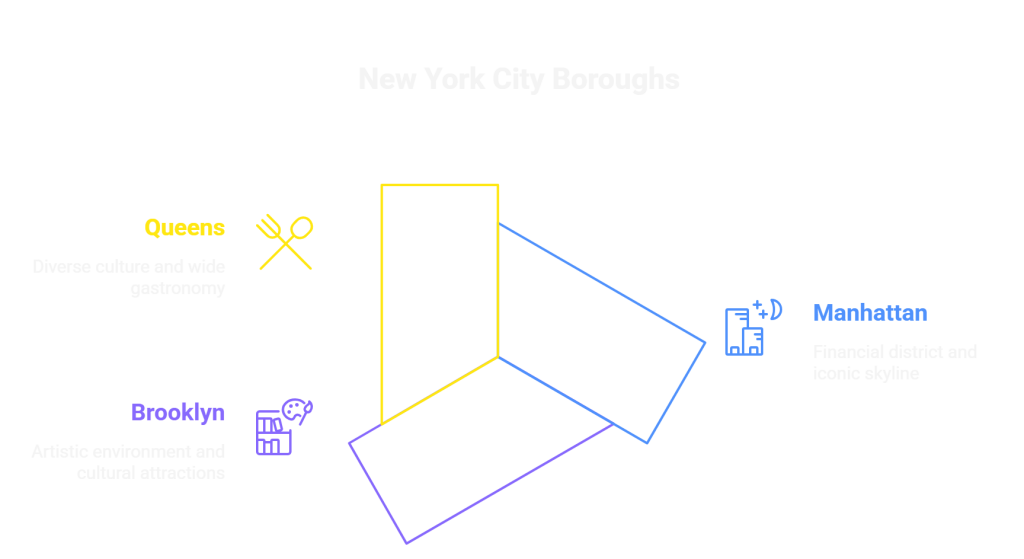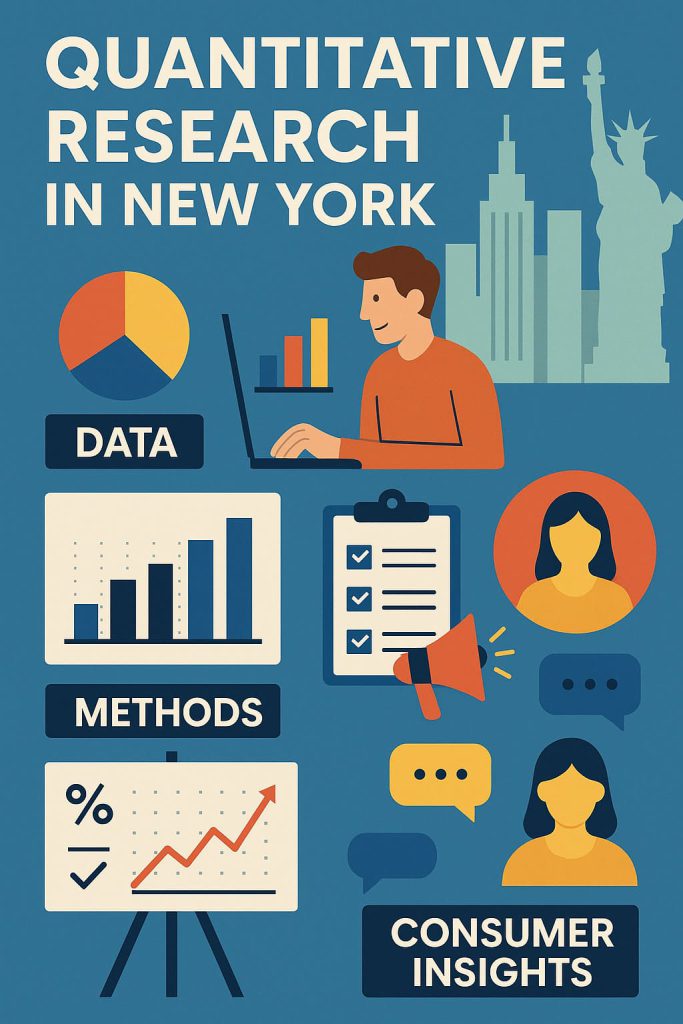Quantitative Research in New York

Your research firm won’t tell you this uncomfortable truth: New York breaks conventional quantitative methodologies. The same approaches that work flawlessly in Dallas or Atlanta lead to catastrophic failures here.
Let me show you why smart money is completely reinventing quantitative research in New York – and why you should be terrified if you’re still using traditional methods.
Table of Contents
✅ Listen to this PODCAST EPISODE here:
What is Quantitative Research in New York?
Quantitative research in New York is more than simple calculations and spreadsheets; it is a full-scale battle in a city that serves as the biggest consumer hub in the world.
Most companies consider quantitative research to be surveys and collected data. This entire concept is very naïve.
It involves accurately estimating the buying behavior of people in a city with more than 8 million inhabitants, who produce the most complicated market dynamics. So, companies are no longer just collecting data but attempting to crack the algorithms that forecast the evolution of consumers in America.
The New York Numbers Advantage
A single quantitative research study in New York can potentially collect a statistically relevant sample from over 50 cultural communities, twelve income groups, six education levels, and four age groups, all within a single metropolitan area.
The Statistical Sophistication Factor
Quantitative research in New York utilizes sample metrics alongside demographics sophisticated enough to turn simple calculations into predictive analytics. Surveying 2,000 New Yorkers is not just about understanding New York, but also about anticipating the purchasing behavior of the entire US population through the world’s premier trendsetting hub.
The Economic Measurement Laboratory
The New York Metro Area is a perfect case study for economists as its consumers are under economic constraints that forecast the entire population’s behavior during financial tightness.
The Cultural Mathematics Revolution
Quantitative research in New York relies on cultural behavioral data as a proxy for demographics to derive psychographics, completing the cultural assumptions gap.
The Digital Behavior Analytics
Quantitative research in New York examines and forecasts American digitized living integration to everyday routines through pattern tracking of social media participation, online purchase rate altitude, and technology adoption phases.
Quantitative Research in New York: Key Market Intelligence
What Makes Quantitative Research in New York So Valuable?

Beyond mere marktonderzoek, quantitative research in New York predicts market behavior. With over 8 million residents, New York’s consumers accumulate behavioral analytics that predict American trends 6-18 months in advance of other markets.
Smaller markets cannot compete with the confidence intervals that quantitative research in New York achieves. Proper sampling in New York allows for a 95% confidence interval with a margin of error lower than 2%. That level of precision makes room for strategic decision-making based on absolute mathematical certainty rather than educated guesses.
Additionally, the diversity offered in New York provides opportunities for quantitative research on measuring long-term consumer behavior stemming from the ever-evolving multicultural landscape of America. Differences in the consumption of goods such as the frequency of purchases, loyalty to a specific brand, and sensitivity to the pricing offered among cultural groups all have quantifiable interrelations between culture and consumption.
Merging Market Research with Business Strategy
Like a costly calculator, most firms treat quantitative research in New York as an afterthought. Based on intuition and unproven competitive analysis, they capture metrics, analyze data, assemble PowerPoint presentations, and continue business as usual.
This attitude reduces intelligent statistics to nothing more than a decoration for the corporation.
Elite firms turn to quantitative research in New York as an advantage to create sophisticated mathematical models to anticipate changes in the market, optimize critical decisions, and formulate competitive edges through unmatched understanding of the consumers’ needs and wants.
The Mathematical Strategy Framework
Phase 1: Predictive Intelligence Architecture
Turning quantitative research in New York into continuous consumer, competitor, and market behavior monitoring transforms outdated, periodic studies into real-time mathematical modeling. Predictive models can now highlight shifts in market opportunities long before they are identified through conventional analysis.
Phase 2: Statistical Decision Enhancement
Allocate funds for market targeting, alter positioning, and craft competition strategies for command reception based on confidence intervals derived from quantitative research in New York data integrated during relevant phases of the decision-making process.
Phase 3: Competitive Warfare in Advanced Math
Employ quantitative research in New York to analyze competitors’ activities, track their market share, and pinpoint strategic weaknesses through rigorous statistical evaluations capable of revealing hidden insights that escape qualitative analyses.
Phase 4: The Real-Time Analytics Integration
Elite quantitative research in New York integration facilitates strategic flexibility by providing insight-driven predictive agility with real-time metrics and math modeling, empowering informed decision-making.
Continuous Measurement Systems:
- Weekly monitoring of key consumer engagement metrics
- Monthly assessment of competition performance
- Quarterly analysis of recurring patterns and forecasting
- Annual strategic planning and forecasting using a defined mathematical model
Strategic Decision Optimization:
- Statistical model-based ROI prediction-guided budget allocation
- Creation of consumer-influenced design-guided product development
- Behavioral analytics-informed marketing plan development
- Advanced mathematical evaluation determines market potential for expansion.
Phase 5: The Predictive Strategy Advantage
Taking advantage of market opportunities through identification and assessment becomes easier with more precise information models enhanced by quantitative research in New York. Strategic decisions based on calculated statistical risk rather than high-level corporate speculation and competitive intelligence ensure higher chances of success.
Metrics for Evaluating Success Post Integration:
- Improvement of strategic decision accuracy through statistical navigation relies heavily on data-driven analysis.
- Mathematical modeling outlines the accuracy of the market predictions made.
- Measurement of the time a competitive advantage can be held surpasses in value through superior measurement.
- Innovation success probabilities are scrutinized through an analysis of consumer behavior mathematics.
Table 1. Quantitative Research in New York: Key Market Intelligence
Quantitative Research in New York: Key Market Intelligence
| Categorie | Key Metric | Waarde | Authoritative Source |
|---|---|---|---|
| Market Research Industry Overview | |||
| Global Market Size | Market research industry revenue (2024) | $140 billion | ESOMAR Global Market Research Report |
| US Market Leadership | US share of global market research revenue | 55% ($48 billion) | AIMultiple Market Research Statistics |
| Quantitative Research Dominance | Online/mobile quantitative research share | 35% of revenues | Statista Market Research Industry |
| Survey Method Preference | Researchers using online surveys regularly | 85% | Backlinko Market Research Statistics |
| New York Metropolitan Area Demographics | |||
| Population | NYC metropolitan statistical area population | 20.1 million | U.S. Census Bureau via Wikipedia |
| NYC Population | New York City population (2024) | 8.5 million | NYC Population Statistics Report |
| Culturele diversiteit | Languages spoken in NYC | 800+ | NYC Demographics Analysis |
| Foreign-Born Population | NYC residents born outside the U.S. | 3.2 million | U.S. Census Bureau Demographics |
| Consumer Spending Patterns | |||
| Metro Area Spending | Average annual household expenditures (NYC Metro, 2022-23) | $90,291 | U.S. Bureau of Labor Statistics |
| National Comparison | National average household expenditures (2023) | $75,172 | U.S. Bureau of Labor Statistics |
| Housing Costs | Housing share of NYC metro household budget | 37.2% | U.S. Bureau of Labor Statistics |
| Median Income | NYC median household income | $76,577 | North American Community Hub |
| Survey Methodology & Response Rates | |||
| Mobile Survey Adoption | Survey responses from mobile devices (Q3 2024) | 61.1% globally | SurveyMonkey Research Data |
| US Mobile Usage | Mobile survey responses in US (Q3 2024) | 51.5% | SurveyMonkey Research Data |
| Expected Response Rates | Target survey response rate (academic standard) | 60%+ | AAPOR Response Rate Standards |
| Industry Variation | B2B vs B2C response rates | 23-32% vs 13-16% | BlitzLlama Survey Research Guide |
| AI & Technology Integration | |||
| AI Adoption | Researchers using AI regularly in market research | 47% | Qualtrics Market Research Trends |
| Synthetic Data Usage | Market researchers incorporating synthetic data | 69% | Market Research Statistics Report |
| Investment Plans | Organizations planning AI investment in research (2025) | 83% | Qualtrics AI Research Survey |
The Dangerous Illusion of New York Quantitative Research

Most market research is built on a simple premise: with the right sample size and methodology, you can project findings from a subset of consumers to the broader market.
That fundamental assumption collapses spectacularly in New York.
Why? Because New York isn’t a single market that can be sampled and projected. It’s dozens of micro-economies with wildly divergent consumption patterns that conventional methodologies completely fail to capture.
Their aggregate data showed strong demand for their concept, concealing a devastating reality: enthusiastic support in just two neighborhoods and active rejection everywhere else. Their “statistically significant” findings were statistically significant nonsense.
The Fatal Flaws Destroying Your Data
The Aggregation Trap
The most dangerous mistake in quantitative research in New York is treating borough-level or citywide data as meaningful.
A 27% positive response in Manhattan and a 27% positive response in Queens aren’t remotely comparable. They represent different consumer segments with radically different spending power, behavior patterns, and competitive alternatives.
One hospitality brand learned this when its quantitative research in New York showed “strong demand” in Brooklyn. Their aggregate data concealed intense enthusiasm in three neighborhoods that mathematically canceled out active hostility in seven others.
This critical distinction would have saved them from a location decision that burned $3.2 million before they surrendered.
The Static Snapshot Delusion
New York consumer preferences evolve at warp speed. Point-in-time research that’s valid in January becomes actively misleading by March.
Yet most companies still conduct periodic quantitative research in New York, and preferences remain stable between measurement cycles. This time-lagged approach virtually guarantees that you’ll solve yesterday’s problems while missing tomorrow’s opportunities.
The Methodological Revolution Smart Companies Are Embracing

Micro-Market Sampling Architectures
Innovative companies have abandoned borough-level and citywide projections entirely. Instead, their quantitative research in New York implements micro-market sampling architectures that ensure statistical validity at the neighborhood level.
Mobile-Native Methodologies
New Yorkers live in perpetual motion, checking their phones during 8-second elevator rides and 90-second subway platform waits. Traditional surveys designed for desktop completion see abysmal response rates and catastrophic sampling bias.
Forward-thinking firms have completely reimagined quantitative research in New York with mobile-native methodologies that capture responses during these micro-moments throughout the day.
Transit-Centric Analysis Frameworks
While travel plans play a significant role in how New Yorkers spend, most research in the city assumes that people go directly from home to their shopping destinations. Today, innovative researchers use transit lines to map people and notice spending patterns beyond neighborhood limits.
The Borough-By-Borough Reality That’s Costing You Millions

✔️ Manhattan:
The most dangerous assumption in quantitative research in New York? That “Manhattan consumers” represent a coherent segment.
The quantitative differences between Upper East Side and Lower East Side consumers aren’t just significant – they’re often inverse. What drives purchase in one actively repels purchase in the other.
A luxury brand discovered this when its quantitative research in New York showed strong appeal in “Manhattan.” When it implemented neighborhood-specific analysis, it discovered that its messaging resonated exclusively with old-money enclaves while actively offending downtown consumers.
This critical distinction saved them from a potentially brand-killing communication strategy focused on heritage and tradition that would have alienated the downtown customers driving their actual growth.
✔️ Brooklyn:
Brooklyn is the product innovation laboratory for the entire country. What happens in Williamsburg today will reach Chicago in 8 months and suburban markets in 18 months.
Yet most quantitative research in New York treats Brooklyn as another data point rather than leveraging its unique predictive power.
✔️ Queens:
Queens offers unparalleled cultural diversity. Yet most quantitative research in New York either under-samples Queens or fails to leverage its unique multicultural insights. Forward-thinking companies now conduct specialized quantitative research in New York’s Queens neighborhoods to simultaneously test concepts across multiple cultural contexts – providing global insights without international research costs.
The Advanced Techniques Creating Unfair Advantages
Behavioral Data Integration
Researchers create multidimensional models that predict actual behavior rather than just stated intentions by fusing traditional metrics with mobile location data, transaction records, and digital footprints.
Continuous Measurement Systems
Point-in-time research snapshots quickly become obsolete in New York’s rapidly evolving marketplace. Innovative companies have abandoned periodic studies entirely in favor of continuous quantitative research through always-on panels.
These longitudinal tracking systems identify preference shifts as they emerge rather than after they’ve become obvious to competitors. The continuous approach delivers three crucial advantages: early trend identification, reduced sampling variance, and the ability to measure actual change rather than methodological noise.
The Hidden Opportunities Most Brands Are Missing

✔️ The Rapid-Response Advantage
Although most brands are processing what was learned last quarter, leading brands run ongoing research in New York that provides insights into consumers’ weekly behavior.
As a result, they often recognize and handle changing trends far ahead of their competitors. Being quick in these categories can make or break a business’ chances in the market.
✔️ The Micro-Market Opportunity
Most brands waste millions pursuing broad market share in New York when neighborhood-level specialization would deliver far greater returns. Smart companies use micro-targeted quantitative research in New York to identify specific neighborhoods where their concept resonates most strongly, then concentrate resources for a dominant share in those areas rather than diffusing efforts citywide.
✔️ The Transit Corridor Strategy
Innovative brands have stopped organizing their strategy around residential neighborhoods and started thinking about transit corridors – the actual paths along which New Yorkers move through the city. By mapping quantitative research in New York to subway lines rather than zip codes, they identify consumption patterns that traditional geographic analysis completely misses.
Inside the Quantitative Research in New York Toolbox

Key Insights You Can’t Afford to Miss
✅ Analysis at the neighborhood level is necessary. Summary data from entire cities or boroughs can lead leaders to misjudge strategies and make significant mistakes.
✅ Mobile-native working methods are much more effective than older approaches in New York. Ensure your online content is accessible in 45 seconds or less, allowing users to access it on the go at any time.
✅ People follow transit habits more closely than they follow the distance from home to their job—associate customers with subway lines and zip codes.
✅ Combining behavioral data helps reveal where New Yorkers say doesn’t align with their actions.
✅ Regular tracking with panels gives you early notice when consumers’ preferences are shifting.
✅ Because Brooklyn mirrors national shifts before they happen, you can spot future patterns early on, while your competitors still wait.
✅ Volumes of foreign consumers are seen in Queens, so learning from them can reveal how an idea or product would do abroad without you spending money to investigate overseas.
✅ Analysts using AI find connections that earlier approaches didn’t notice.
Why SIS International Dominates New York Quantitative Research
Bij SIS Internationaal, we’ve reinvented quantitative research in New York from the ground up. Here’s why data-driven companies trust us with their most critical strategic decisions:
🔹MICRO-MARKET METHODOLOGIES: We’ve abandoned broad projections in favor of neighborhood-level analysis that captures the crucial variations conventional approaches miss. Our specialized quantitative techniques reveal opportunities others never discover.
🔹PROPRIETARY SAMPLING FRAMEWORKS: Our recruitment channels target affluent professionals, cultural influencers, and emerging demographics that standard panels often overlook.
🔹MOBILE-NATIVE SURVEY DESIGN: We’ve reimagined data collection for New York’s fractured attention spans – ultra-short, single-thumb completion optimized for subway platforms and elevator rides.
🔹BEHAVIORAL DATA INTEGRATION: We fuse survey responses with location data, transaction records, and digital footprints to identify the frequent disconnects between stated intentions and actual behavior.
🔹CONTINUOUS MEASUREMENT SYSTEMS: Our always-on panels track evolving preferences in real-time rather than providing outdated quarterly snapshots.
🔹TRANSIT-CENTRIC ANALYSIS: We map respondents to subway lines rather than just neighborhoods, identifying consumption corridors that transcend traditional geographic boundaries.
🔹AI-ENHANCED PREDICTIVE MODELING: Our machine learning capabilities identify non-obvious relationships in complex datasets, predicting neighborhood-specific responses with precision that transforms strategy development and resource allocation.
Veelgestelde vragen
How do I know if my current research is fundamentally flawed?
Start by examining whether your results show meaningful neighborhood-level variations. If your quantitative research in New York shows consistent patterns across dramatically different areas, that’s a blaring alarm indicating methodological failures.
Review your sample composition critically. Does it include the affluent professionals and tastemaker segments that drive trends, or just people who take surveys? Response rates below 25% virtually guarantee unrepresentative samples, regardless of how beautifully they’re weighted.
What sample sizes and structures actually deliver reliable insights?
Forget conventional wisdom about sample sizes. For quantitative research in New York, structure matters infinitely more than size. A perfectly representative sample of 600 respondents with proper neighborhood stratification delivers more accurate insights than 3,000 respondents from a conventional panel with inherent sampling bias.
How should pricing research differ in New York?
Standard pricing methodologies fail catastrophically in New York due to extreme neighborhood-level variations in price sensitivity and value perception.
Effective pricing research requires neighborhood-specific designs for local competitive alternatives and spending patterns. What represents value in Astoria differs dramatically from what constitutes value in Tribeca.
What technological innovations are actually transforming research quality?
Mobile-optimized survey methodologies that capture responses during transit and micro-breaks have dramatically improved completion rates among time-starved New Yorkers.
Location-based sampling leverages smartphone geolocation to ensure representative coverage across neighborhoods and transit corridors that shape consumption patterns.
Most transformatively, AI-enhanced analytics now identify non-linear relationships in complex datasets that would be impossible for human analysts to discover. These advanced modeling capabilities predict neighborhood-specific responses with unprecedented accuracy.
How can I leverage New York research to gain a national advantage?
The most innovative companies use New York as their innovation laboratory and early warning system for national trends. They over-sample Brooklyn to identify emerging preferences 8-16 months before they appear in national data, gaining crucial first-mover advantages in product development and messaging.
They test concepts across Queens’ diverse cultural communities to predict international market response without expensive global research programs.
What should high-quality New York research actually cost?
Effective quantitative research costs more in New York than standard approaches. The specialized recruitment strategies, enhanced sampling frameworks, and advanced analytics required for valid insights represent significant investments.
However, these costs pale compared to the millions wasted on failed market entry, misguided expansion, or tone-deaf messaging based on flawed research. The real question isn’t whether you can afford quality research, but whether you can afford the consequences of cutting corners.
Onze vestigingslocatie in New York
11 E 22nd Street, 2e verdieping, New York, NY 10010 T: +1(212) 505-6805
Over SIS Internationaal
SIS Internationaal offers Quantitative, Qualitative, and Strategy Research. We provide data, tools, strategies, reports, and insights for decision-making. We also conduct interviews, surveys, focusgroepen, and other Market Research methods and approaches. Neem contact met ons op voor uw volgende marktonderzoeksproject.


